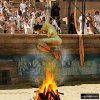seekerofher
Guard
Soon enough my dear.View attachment 316836I hope I can take it. I want to be brave ... tough it out. But can I do it? Oh, the waiting is so awful. Let's get on with it.

Soon enough my dear.View attachment 316836I hope I can take it. I want to be brave ... tough it out. But can I do it? Oh, the waiting is so awful. Let's get on with it.
How do these guys get these jobs? I was born in the wrong century. Should have been back then enjoying my job.View attachment 594341
BIBIANA OF ROME SCOURGED TO DEATH
Bibiana was a native of Rome, born in the fourth century, the daughter and sister of martyrs. Flavian, her Christian father, was apprehended during the reign of Julian the Apostate, branded on the face as a slave, and banished to Toscany, where he died of his wounds a few days later. Her mother, Dafrosa, was beheaded two weeks later. Their two daughters, Bibiana and Demetria, after the death of their parents were stripped of all they had in the world, and then imprisoned with orders to give them no food. The Roman praetorian offered them rewards if they would abandon their faith, and threatened a cruel death if they would not conform, but they replied courageously that the goods and advantages of this world had no attraction for them, and that they would endure a thousand deaths rather than betray their faith and their Saviour. Demetria, after having pronounced this ardent defense, fell to the ground and expired at her sister's side.
The officer gave orders that Bibiana be placed in the custody of a woman named Rufina, who was commanded to corrupt her or mistreat her. But the martyr made prayer her shield and remained invincible. Enraged at the courage and perseverance of the young virgin, the persecutor ordered her to be tied to a pillar and whipped until she expired, with scourges tipped with leaden plummets. The Saint underwent this punishment cheerfully, and died at the hands of the executioners. She was buried by a holy priest at a site where afterwards a chapel and then a church were built above her tomb.
Like anything else, it probably gets old after a while. And not everyone is young and comely. Then, there's blood-borne disease, and somebody has to clean up the mess. As a kid, I toured a candy factory where employees were allowed to grab what they wanted off the line. "At first, you pig out. That lasts about a week." Now, if you were a senior employee, and got to pick the victims you would deal with, maybe it would be different.How do these guys get these jobs? I was born in the wrong century. Should have been back then enjoying my job.

Talk about letting the punishment fit the crime - that's a great scene!View attachment 605652
SLAVE PLAUTILLA BURNED ALIVE FOR ARSON
The crime of incendium was the subject of one of the laws of the Twelve Tables, which inflicted a severe punishment on the person who set fire to property maliciously (sciens, prudens). The punishment, however, of burning alive, which is mentioned in the passage of the Digest referred to, is supposed by modern commentators not to have been contained in the Twelve Tables, but to have been transferred from the imperial period to earlier times. In the second Punic war a great fire broke out at Rome, which was evidently occasioned humana fraude. The offenders were discovered and punished (animadversum est), but Livy unfortunately does not state (XXVI.27) in what manner. We find mention of execution by the sword, burning alive, condemnation to the mines and to public works, deportatio, relegatio, flogging, &c., as punishments inflicted on account of incendium. If a slave was judged as being guilty of malicious arson, the penalty was being burned alive. Mention is found about a female slave whose name was Plautilla, who was condemned to die by fire for burning her lord’s villa.


She was violently scourged in public and then killed with a sword.
View attachment 624462View attachment 624463




View attachment 629207
ZOE OF ROME BURNED AS A CHRISTIAN
Zoe of Rome (died c. 286) was a noblewoman, married to Nicostratus, a high Roman court official. For six years she had been unable to speak. Saint Sebastian made the sign of the cross over the woman, and she immediately began to speak and she glorified Jesus. Nicostratus and his wife asked for baptism. She lived during the reign of Emperor Diocletian and his early persecution of Christians.
She was greatly devoted to Saint Peter, and was praying by his tomb when she was arrested for her faith. She died, burnde and stifled by smoke, hung over a fire. Her body then was thrown into the River Tiber.
View attachment 629208View attachment 629209
View attachment 629207
ZOE OF ROME BURNED AS A CHRISTIAN
Zoe of Rome (died c. 286) was a noblewoman, married to Nicostratus, a high Roman court official. For six years she had been unable to speak. Saint Sebastian made the sign of the cross over the woman, and she immediately began to speak and she glorified Jesus. Nicostratus and his wife asked for baptism. She lived during the reign of Emperor Diocletian and his early persecution of Christians.
She was greatly devoted to Saint Peter, and was praying by his tomb when she was arrested for her faith. She died, burnde and stifled by smoke, hung over a fire. Her body then was thrown into the River Tiber.
View attachment 629208View attachment 629209


